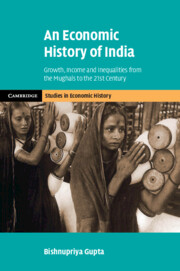Book contents
- An Economic History of India
- Cambridge Studies in Economic History
- An Economic History of India
- Copyright page
- Dedication
- Contents
- Figures
- Maps
- Tables
- Acknowledgements
- Introduction
- 1 The Decline and the Rise of the Indian Economy
- 2 Agriculture as the Engine of Growth
- 3 From Handlooms to Modern Industry and the Emergence of a Planned Economy
- 4 Origins of India’s Service Sector Advantage
- 5 Region, Income, Caste, and Gender
- 6 Colonial Development in a Comparative Perspective
- Conclusion
- References
- Index
3 - From Handlooms to Modern Industry and the Emergence of a Planned Economy
Published online by Cambridge University Press: 06 February 2025
- An Economic History of India
- Cambridge Studies in Economic History
- An Economic History of India
- Copyright page
- Dedication
- Contents
- Figures
- Maps
- Tables
- Acknowledgements
- Introduction
- 1 The Decline and the Rise of the Indian Economy
- 2 Agriculture as the Engine of Growth
- 3 From Handlooms to Modern Industry and the Emergence of a Planned Economy
- 4 Origins of India’s Service Sector Advantage
- 5 Region, Income, Caste, and Gender
- 6 Colonial Development in a Comparative Perspective
- Conclusion
- References
- Index
Summary
Chapter 3 is about industry. The decline of the traditional textile industry is analysed in the context of competition from the new technology of the British industrial revolution. This sector was small part of the economy. A modern industrial sector developed from the middle of the nineteenth century, which was more productive than the traditional sector and it grew rapidly. In 1947, the shares of the modern and the traditional sectors were roughly the same. Entrepreneurship and capital for the modern import substituting cotton textile industry came from the Indian trading communities. British investment in industry was in the exporting sectors, such as tea and jute. After 1947, India adopted a strategy of intermediate and capital goods led industrialization. The process of industrialization was led by the public sector with highly interventionist policies towards trade and industrial location. The role of the private sector was constrained. Yet, the industrial conglomerates owned by family based enterprises prospered and dominated the industrial sector in second half of the twentieth century.
Keywords
- Type
- Chapter
- Information
- An Economic History of IndiaGrowth, Income and Inequalities from the Mughals to the 21st Century, pp. 77 - 107Publisher: Cambridge University PressPrint publication year: 2025

